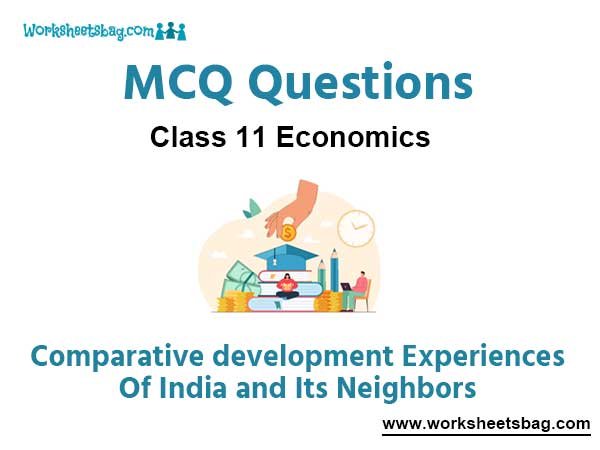Please refer to MCQ Questions Chapter 10 Comparative development Experiences Of India and Its Neighbors Class 11 Economics with answers provided below. These multiple-choice questions have been developed based on the latest NCERT book for class 11 Economics issued for the current academic year. We have provided MCQ Questions for Class 11 Economics for all chapters on our website. Students should learn the objective based questions for Chapter 10 Comparative development Experiences Of India and Its Neighbors in Class 11 Economics provided below to get more marks in exams.
Chapter 10 Comparative development Experiences Of India and Its Neighbors MCQ Questions
Please refer to the following Chapter 10 Comparative development Experiences Of India and Its Neighbors MCQ Questions Class 11 Economics with solutions for all important topics in the chapter.
MCQ Questions Answers for Chapter 10 Comparative development Experiences Of India and Its Neighbors Class 11 Economics
Question. Which of the following country was faster in shifting its workforce from agriculture to the service sector?
a) India
b) Pakistan
c) China
d) Both (a) and (b)
Answer
B
Question. The economic growth in various countries is partly due to.
a) Globalisation
b) Privatisation
c) Liberalisation
d) All of the above
Answer
A
Question. The five year plan in Pakistan is now known as.
a) Planning development
b) People’s plan
c) Medium term development plan
d) None of the above
Answer
C
Question. In the later phase of reforms in China, reforms were introduced under.
a) Private sector firms
b) Trade policy
c) Investment sector
d) Banking sector
Answer
A
Question. Which of the following countries has introduced the one-child norm?
a) China
b) India
c) Pakistan
d) Bangladesh
Answer
C
Question. Who said these lines “these new and revolutionary changes in China and India, even though they differ in content, symbolise the new spirit of Asia and new vitality which is finding expression in the countries in Asia.”
a) B.R.Ambedkar
b) Jawaharlal lal Nehru
c) Mahatma Gandhi
d) Rajendra Prasad
Answer
B
Question. “The poverty reemerged in Pakistan”. What are the possible reasons for this?
a) Agricultural growth was not based on institutionalised process of technical change
b) Foreign exchange requirements of Pakistan
c) Non-developmental activities
d) All of the above
Answer
D
Question. The fertility rate is very low in ______ and very high in _____.
a) India , China
b) China , Pakistan
c) Pakistan, China
d) India , Pakistan
Answer
B
Question. “Reforms were introduced in China”, because
a) The new leadership wasn’t happy with the slow pace of growth and lack of modernisation
b) Maoist vision had failed
c) Both (a) and (b)
d) None of the above
Answer
C
Question. When were economic reforms initiated in China?
a) 1978
b) 1988
c) 1990
d) 1991
Answer
A
Question. In which of the following indicators is Pakistan ahead of India and China?
a) Urbanisation
b) Fertility rate
c) Density
d) Population
Answer
B
Question. Which of the following were reason of slow growth rate in Pakistan
a) Reliance on remittances
b) Political instability
c) Growing dependence on foreign loans
d) Both (a) and (b)
Answer
D
Question. What was the fertility rate in Pakistan as in 2018?
a) 1.6
b) 2.6
c) 3.6
d) 3.6
Answer
C
Question. Which currency is universally accepted
a) Yuan
b) Dollar
c) Rupee
d) Euro
Answer
B
Question. The growth rate of the population is highest in which of the following country?
a) India
b) China
c) Pakistan
d) None of these
Answer
C
Question. Human Development Index (HDI) include
a) Both
b) Quantitative aspect
c) None
d) Qualitative aspect
Answer
A
Question. Structural changes is
a) Change in the relative contribution of tertiary sector of Indian economy
b) Change in the relative structure of primary sector of Indian economy
c) All of these
d) Change in the relative contribution of primary sector of Indian economy
Answer
D
Question. Which of the following is false regarding China
a) Sex ratio is biased and low
b) Density of population is lowest
c) Population is very small
d) Fertility rate is low
Answer
B



